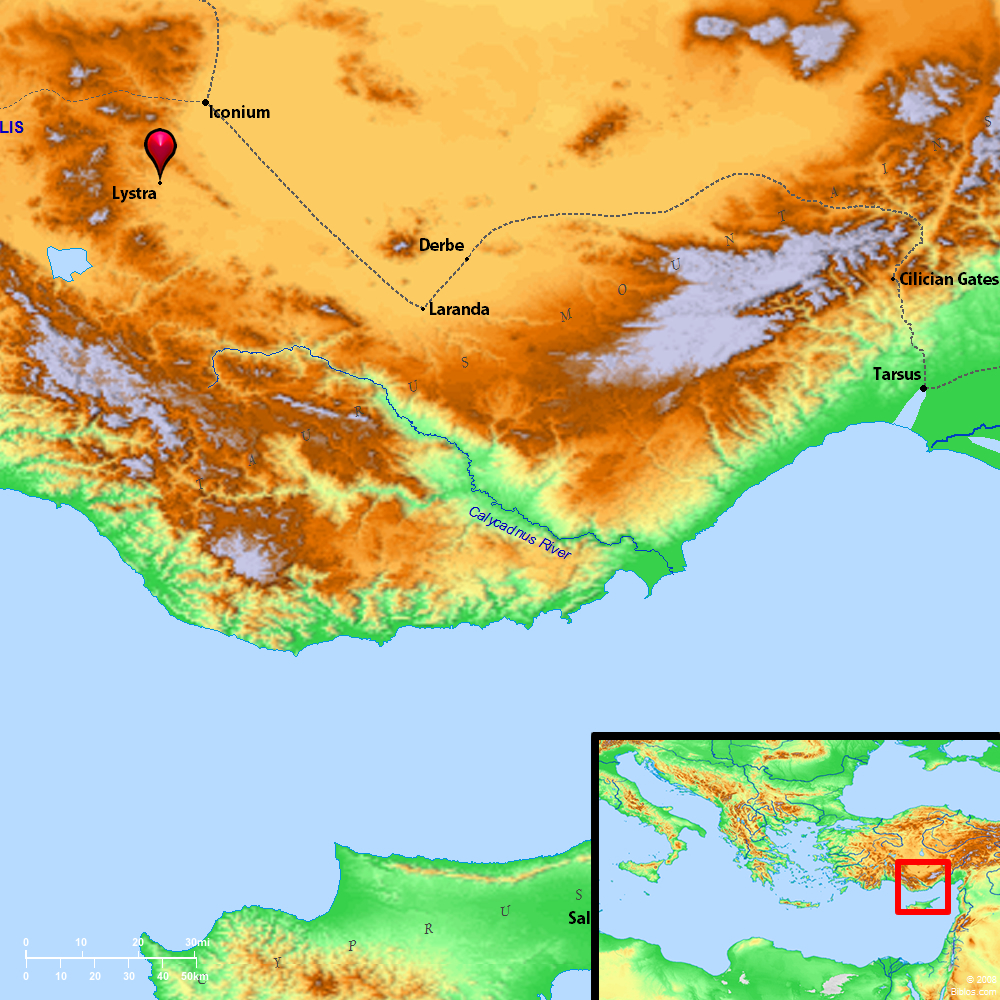Atlas

Lystra and surrounding region
Maps Created using Biblemapper 3.0Additional data from OpenBible.infoOccurrences
Acts 14:6 they became aware of it, and fled to the cities of Lycaonia, Lystra, Derbe, and the surrounding region.
Acts 14:8 At Lystra a certain man sat, impotent in his feet, a cripple from his mother's womb, who never had walked.
Acts 14:21 When they had preached the Good News to that city, and had made many disciples, they returned to Lystra, Iconium, and Antioch,
Acts 16:1 He came to Derbe and Lystra: and behold, a certain disciple was there, named Timothy, the son of a Jewess who believed; but his father was a Greek.
Acts 16:2 The brothers who were at Lystra and Iconium gave a good testimony about him.
2 Timothy 3:11 persecutions, and sufferings: those things that happened to me at Antioch, Iconium, and Lystra. I endured those persecutions. Out of them all the Lord delivered me.
Encyclopedia
LYSTRAlis'-tra: The forms Lustran, and Lustrois, occur. Such variation in the gender of Anatolian city-names is common (see Harnack, Apostelgeschichte, 86; Ramsay, Paul the Traveler, 128). Lystra was visited by Paul 4 times (Acts 14:6, 21; Acts 16:1; Acts 18:23 -the last according to the "South Galatian" theory), and is mentioned in 2 Timothy 3:10 as one of the places where Paul suffered persecution. Timothy resided in Lystra (Acts 16:1).
1. Character and Site:
Lystra owed its importance, and the attention which Paul paid to it, to the fact that it had been made a Roman colonia by Augustus (see ANTIOCH), and was therefore, in the time of Paul, a center of education and enlightenment. Nothing is known of its earlier, and little of its later, history. The site of Lystra was placed by Leake (1820) at a hill near Khatyn Serai, 18 miles South-Southwest from Iconium; this identification was proved correct by an inscription found by Sterrett in 1885. The boundary between Phrygia and Lycaonia passed between Iconium and Lystra. (Acts 14:6) (see ICONIUM).
The population of Lystra consisted of the local aristocracy of Roman soldiers who formed the garrison of the colonia, of Greeks and Jews (Acts 16:1, 3), and of native Lycaonians (Acts 14:11).
2. Worship of Paul and Barnabas:
After Paul had healed a life-long cripple at Lystra, the native population (the "multitude" of Acts 14:11) regarded him and Barnabas as pagan gods come down to them in likeness of men, and called Barnabas "Zeus" and Paul "Hermes." Commentators on this incident usually point out that the same pair of divinities appeared to Baucis and Philemon in Ovid's well-known story, which he locates in the neighboring Phrygia. The accuracy in detail of this part of the narrative in Acts has been strikingly confirmed by recent epigraphic discovery. Two inscriptions found in the neighborhood of Lystra in 1909 run as follows:
(1) "Kakkan and Maramoas and Iman Licinius priests of Zeus";
(2) "Toues Macrinus also called Abascantus and Batasis son of Bretasis having made in accordance with a vow at their own expense (a statue of) Hermes Most Great along with a sun-dial dedicated it to Zeus the sun-god."
Now it is evident from the narrative in Acts that the people who were prepared to worship Paul and Barnabas as gods were not Greeks or Romans, but native Lycaonians. This is conclusively brought out by the use of the phrase "in the speech of Lycaonia" (Acts 14:11). The language in ordinary use among the educated classes in Central Anatolian cities under the Roman Empire was Greek; in some of those cities, and especially of course, in Roman colonies, Latin also was understood, and it was used at this period in official documents. But the Anatolian element in the population of those cities continued for a long time to use the native language (e.g. Phrygian was in use at Iconium till the 3rd century of our era; see ICONIUM). In the story in Acts a fast distinction is implied, and in fact existed, between the ideas and practices of the Greeks and the Roman colonists and those of the natives. This distinction would naturally maintain itself most vigorously in so conservative an institution as religious ritual and legend. We should therefore expect to find that the association between Zeus and Hermes indicated in Acts belonged to the religious system of the native population, rather than to that of the educated society of the colony. And this is precisely the character of the cult illustrated in our two inscriptions. It is essentially a native cult, under a thin Greek disguise. The names in those inscriptions can only have been the names of natives; the Zeus and Hermes of Acts and of our inscriptions were a graecized version of the Father-god and Son-god of the native Anatolian system. The college of priests which appears in inscription number 1 (supporting the Bezan variant "priests" for "priest" in Acts 14:13) was a regular Anatolian institution. The miracle performed by Paul, and his companionship with Barnabas would naturally suggest to the natives who used the "speech of Lycaonia" a pair of gods commonly associated by them in a local cult. The two gods whose names rose to their lips are now known to have been associated by the dedication of a statue of one in a temple, of the other in the neighborhood of Lystra.
LITERATURE.
Ramsay, Cities of Paul, 407;. On the new inscriptions, see Calder, The Expositor, 1910, 1;, 148;; id, Classical Review, 1910, 67;. Inscriptions of Lystra are published in Sterrett, Wolfe Expedition, and in Jour. Hell. Stud., 1904 (Cronin).
W. M. Calder
LYSTRA, supposed to have been at Bin-bir-Kilissi, "the thousand and one churches," on the eastern declivity of a lofty mountain, 420 ms. n.n.w. from Jerusalem, and 100 ms. n. of the Mediterranean in the province of Lycaonia.
Strong's Greek
G3082: LustraLystra, a city of Lycaonia




